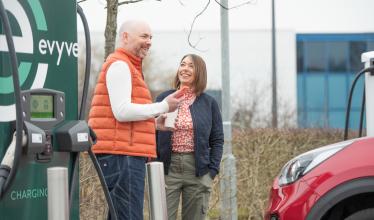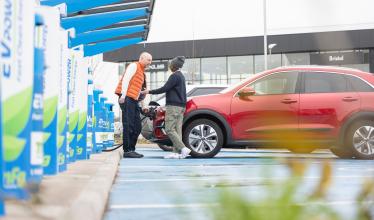Electric vans have really taken off. A large number of new models coming to market in the past 12 months or so has seen what was once a very small choice of models expand dramatically.
Only a year or so ago, there were a handful of electric vans available. All were relatively compact and had a short range, but that’s all changed. There are electric options across all van classes, and driving ranges have increased from ‘last-mile’ specialists to delivery vehicles capable of being used all day – in town or outside.
The benefits of electric vans
Of course, the natural benefits of electric vans – responsive drive and zero tailpipe emissions – remain, but they are no longer the one-trick ponies EV LCVs once were.
With improved load space available, larger battery capacities for longer ranges, and significant financial savings in terms of fuel, maintenance and tax costs, electric vans now offer a realistic and practical alternative to diesel models in most situations.
With a number of models now boasting ranges considerably over 100 miles on a charge, plug-in vans are no longer limited to small areas, and would ideally suit a variety of businesses. Follow the link below to see the best electric vans available in the UK.
Below, we highlight the key factors to consider when looking at an electric van.
Electric van range

Until recently, a typical range available for an electric van was around 80-90 miles on a charge. While this is ample for a number of businesses, it’s not particularly flexible, and could easily prove too short for those driving further than within a small delivery area.
Long-range electric vans
Recent additions to the electric van market mean range is less of an issue, with new available EV models coming along boasting a range of close to 200 miles on a charge.
As with all electric vehicles, range will fluctuate a little depending on weather conditions, driving style, speeds and load. Clearly, however, an electric van’s load can easily be far greater than that of an electric car.
As such, for those covering larger areas, a long-range model can be considered essential. With an official range figure of 186 miles, the Peugeot e-Expert could easily see a real-world range fall to a bit over 100 miles when fully loaded and being driven in winter.
While it’s not much of an issue with a van featuring an official range of almost 200 miles, removing almost half an LCV’s driving range when the official figure is only around 80 miles is far more significant.
The range of electric vans can be hit hard by load and weather, but many vans will see driving range boosted with regular urban driving. The stop-start nature of driving in towns and cities ideally suits an electric vehicle, with plenty of chance to top up the battery with brake energy recuperation, and few chances to maintain high speed.
Electric van payloads

There are only a few large electric vans available, which means that those looking for a plug-in LCV with a heavy payload will struggle. However, as mentioned above, a heavy payload will dramatically hit driving range, so this is perhaps no bad thing in the current market.
That said, there are a number of LCVs available capable of carrying around 1,000 kg – plus or minus – with plenty of choice available for those looking at medium-sized vans.
For many businesses this will be ample, and won’t affect driving range unduly. Those delivering white goods may struggle with an electric van, but a florists or bakers for example – large loads but relatively lightweight – would have no such issues.
Most electric vans feature similar or matching payloads to diesel counterparts, so the only real question is whether the plug-in version will deal with the required driving range between charges.
Electric van charging

Charging is an essential part of keeping any electric vehicle running, especially so for electric vans. As a working vehicle, drivers and businesses depend on being able to get in and go, relying on the van to get them to wherever required without fear of running out of charge.
As such, having on-site charging at work, at a business’s premises, is highly-recommended, allowing users to plug-in overnight and have a full charge in the morning. Although you can achieve this on public charging points as well, there are greater issues with reliable access – someone else could reasonably get there and charge first – and costs to consider.
New electric vans
Newer electric vans come with higher-capacity on-board chargers, meaning many can now charge at 7 kW – comfortably enough for an overnight charge. Others are capable of charging faster still at 11 or 22 kW where three-phase charging is available. Whilst this is uncommon at domestic properties, three-phase supply at commercial sites is far more common.
Equally, many electric vans are rapid-charge capable, some at 100 kW or more. This is ideal for those with access to rapid charge points and a need to recharge during the day. Put an electric van on a rapid charger during a lunch break, for example, and it will top up a significant proportion of its range in that time to almost double its daily mileage – with no inconvenience.
Find out how to charge the UK’s most popular electric vans with Zapmap’s model charging guides.
Electric van costs

Purchase costs for electric vans tend to be higher than those for comparable diesel models, though there are a number of incentives to help out businesses.
Grants for electric vans and other benefits
Rates for the Plug-in Van Grant (PiVG) are now £5,000 for large vans and £2,500 for small vans, with a limit of 1,000 per customer per year.
(Previously, the PiVG covered 35% of the purchase price for small vans, up to a maximum of £3,000. It also payed for 35% of the purchase price for large vans, up to a maximum of £6,000.)
Electric vans pay no VED and reduced Van Benefit Charge for the next few years at least. Pure-electric LCVs are also eligible for a 100% first year allowance.
With clean air/ultra-low emissions zones (ULEZ) coming in to force in a number of the UK’s urban hubs, electric vans will future-proof owners against costs charged to enter these zones – typically in city centres.
Considering the existing ULEZ in London currently charges £12.50 a day for non-compliant vehicles, those operating in or around a clean air zone could save thousands on charges each year alone. As of 25th October 2021, London’s ULEZ has expanded to cover all areas within the North and South Circular – although the North Circular (A406) and South Circular (A205) roads are not in the ULEZ.
Some of the most significant savings for most will come from fuel costs however. A driver covering only 60 miles a day can easily save more than £1,000 a year in fuel costs alone when comparing an electric van with a similar diesel model.
Electric van driving

Electric vans are better suited to just about all use cases barring long-distance deliveries. With zero tailpipe emissions, they can contribute to significant improvements in local air quality.
Charged with renewable electricity, they make an even greater case as a green form of transport. It’s easy to find 100% renewable-backed energy tariffs or for businesses to install solar panels for example to charge their electric vehicles.
Commercial electric van driving tends to be more stop-start than car usage, which benefits electric range, and also means that those hopping out and leaving the ‘engine’ running isn’t doing additional harm pumping out diesel fumes unnecessarily.
An electric motor’s torque is available from zero rpm, helping to get loads shifted easier than any internal combustion engine. Often with a single gear, or as an automatic at the very least, an electric van is easier to drive than many conventional vans, particularly in urban areas.



